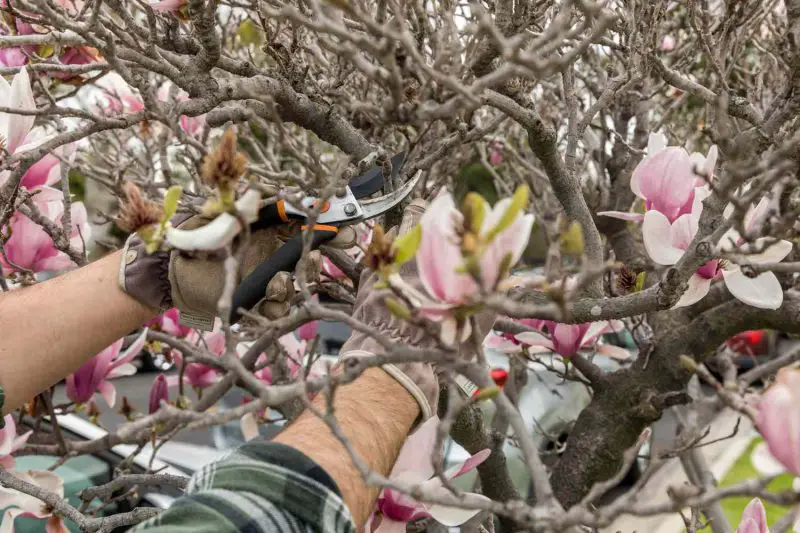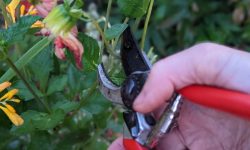There’s something undeniably magical about a magnolia tree in full bloom. With its majestic branches, glossy green leaves, and fragrant blossoms that signal the arrival of a new season, a magnolia is more than just a tree—it’s a living statement of beauty and grace. But behind every breathtaking display is a careful balance of timing, technique, and seasonal care. If you want your magnolia to thrive and bloom abundantly year after year, proper pruning is essential.
In this detailed guide, you’ll learn exactly how to prune a magnolia tree in every season to protect its natural form, encourage healthier growth, and extend its blooming potential. Whether you’re working with a stately Southern magnolia or a delicate star magnolia, the right cut at the right time can make all the difference.
Understanding Magnolia Growth and Structure

Why Seasonal Pruning Matters
Pruning Tools and Preparation
Successful pruning begins with proper tools and thoughtful preparation. Using clean, sharp equipment ensures precise cuts that heal quickly and reduce the risk of disease. For small branches and twigs, bypass hand pruners offer control and clean cuts. Loppers are ideal for medium-sized limbs, while a curved pruning saw works best on thicker branches that require more effort to remove.
Before you begin, inspect your tools and disinfect the blades using a solution of rubbing alcohol or diluted bleach. This step is essential to prevent the spread of pathogens between trees or from infected to healthy branches.
Take time to assess your magnolia from all angles. Step back and identify branches that are dead, diseased, crossing, or growing inward. Plan your cuts in advance and remember that magnolias don’t respond well to aggressive pruning. It’s better to prune lightly over multiple seasons than to make drastic cuts all at once.
Wearing gloves and protective eyewear is also recommended, especially when working with large trees or thick canopies. With careful planning and the right tools in hand, you’ll set the stage for a healthier, more beautiful magnolia tree.
How to Prune a Magnolia Tree in Winter
Structural Pruning and Training
Winter is an excellent time for pruning deciduous magnolias because the tree is dormant and its structure is clearly visible. With no leaves on the branches, you can better evaluate its shape and remove problem limbs.
This season is best for structural pruning, such as correcting weak branch angles, removing crossing limbs, or thinning dense areas that hinder air circulation. Young magnolias can also be lightly trained during this time to encourage a balanced shape and strong central leader.
Avoid heavy pruning in winter for evergreen magnolias, as it may shock the tree. Stick to removing dead or damaged limbs only.
Removing Deadwood
Removing deadwood is one of the simplest yet most important pruning tasks for magnolia trees. Dead branches not only detract from the tree’s appearance but also invite pests and disease. Since dead limbs no longer serve the tree, removing them allows more energy to be directed toward healthy growth and flowering.
Deadwood is easier to spot during winter or early spring when the tree is bare. Look for brittle, leafless branches with peeling bark or a hollow sound when tapped. Always cut back to a healthy branch or just outside the branch collar to promote proper healing and prevent decay. Regular removal of deadwood helps keep your magnolia healthy, safe, and visually appealing year-round.
Addressing Storm Damage
How to Prune a Magnolia Tree in Spring
Spring is a delicate but important time for pruning magnolia trees, particularly for deciduous varieties like saucer or star magnolias that bloom early in the season. These trees set their flower buds in late summer or fall, so pruning before or during blooming can remove the very branches that carry their prized blossoms. To preserve flower displays, wait until the blooms have faded before beginning any pruning.
Once blooming is complete, spring becomes a great time for shaping and tidying. Focus on removing weak, damaged, or crowded branches, especially those that cross and rub against each other. This improves airflow within the canopy and helps reduce the risk of disease. You should also remove suckers growing from the base of the tree and water sprouts—those fast-growing vertical shoots that drain energy from the tree without contributing to its form.
For evergreen magnolias, spring pruning typically starts a bit later, once the risk of frost has passed. This is a good moment to clean up winter damage, trim overly long branches, and gently shape the tree if necessary. Evergreen types respond well to light pruning in late spring as they enter a period of strong growth.
Always use sharp, clean tools and make cuts just outside the branch collar to support healthy healing. Avoid removing large limbs or more than 10–15% of the canopy at once, as magnolias don’t recover quickly from heavy pruning. When done thoughtfully, spring pruning helps refresh the tree’s appearance and supports strong, balanced growth for the rest of the year.
How to Prune a Magnolia Tree in Summer
Summer is a practical and beneficial time to prune magnolia trees, especially after they’ve finished blooming and new growth has had time to mature. During this season, the tree is in an active growth phase, which means it can heal from pruning wounds more efficiently. However, pruning should still be light and carefully targeted, as magnolias are sensitive to over-pruning even in summer.
One of the key tasks in summer is removing water sprouts—those upright, fast-growing shoots that emerge from branches or the trunk. These shoots can sap energy from the tree and spoil its natural form. Cutting them off close to their base helps redirect energy back to the main structure. Basal suckers, which grow from the root zone near the base, should also be removed promptly, as they compete with the main trunk for nutrients and water.
Summer is also a good time to gently control the tree’s height and spread. If some branches are growing too long or out of proportion, you can trim them back slightly to a lateral branch or bud. This kind of directional pruning helps maintain the magnolia’s shape without stressing the tree. It’s important to avoid cutting into old wood, which magnolias don’t regenerate from easily. Focus instead on soft, new growth that has matured but is still flexible.
In dense or crowded areas of the canopy, selective thinning can be done to improve light penetration and airflow. This is especially helpful in humid climates, where poor air circulation can lead to fungal issues like leaf spot or mildew. By opening up the interior of the tree just slightly, you help reduce disease pressure and promote healthier foliage.
Always prune in the early morning or late afternoon to avoid stressing the tree during the hottest part of the day. Use clean, sharp tools and avoid making too many cuts at once. Summer pruning is all about refinement—tidying up the tree’s appearance, correcting minor growth issues, and supporting continued vigor without disrupting its overall balance.
With careful, strategic cuts, summer pruning can keep your magnolia looking elegant, encourage healthy branching, and set the stage for strong bud development in the coming months.
How to Prune a Magnolia Tree in Fall
Fall is a transitional season for magnolia trees, and while it’s not the prime time for major pruning, it can be useful for light maintenance. Once the tree begins to go dormant—usually after the first few frosts and once most leaves have fallen—you can take this opportunity to tidy up minor issues.
Focus on removing dead, damaged, or diseased branches before winter sets in. These cuts help reduce the risk of pest infestation and fungal problems during the cold, wet months. You can also prune small crossing branches or those growing at awkward angles if they’re causing congestion in the canopy.
However, avoid heavy pruning or reshaping in fall, especially on deciduous magnolias. Large cuts made in this season heal more slowly, and removing too much at once may stress the tree before winter dormancy. For significant structural work, wait until late winter or early spring when healing conditions improve.
Fall pruning is best thought of as a gentle cleanup—supporting health and structure without disrupting the next year’s bloom.
Special Considerations for Different Magnolia Types
Pruning Evergreen Magnolias
Southern magnolias and other evergreen varieties require different timing than deciduous species. These trees don’t lose their leaves, so their structure is harder to evaluate. Limit pruning to late spring through summer, when the tree is actively growing and able to recover.
Evergreens tolerate only light pruning. Focus on shaping the lower canopy, removing damaged branches, and thinning overly dense growth. Avoid cutting into large limbs unless absolutely necessary.
Pruning Deciduous Magnolias
Deciduous magnolias like saucer, star, and lily magnolias lose their leaves in fall and bloom in early spring. Because they form flower buds in late summer or early fall, timing is crucial—pruning too early or late can remove the following season’s blossoms.
The best time to prune is in late winter, while the tree is dormant and its structure is visible, or just after blooming in spring. Focus on removing deadwood, suckers, water sprouts, and crossing branches to maintain a healthy, open canopy. Always cut back to a natural branching point and avoid heavy pruning, especially into old wood, as these trees don’t recover well from drastic cuts.
For younger trees, light formative pruning helps develop a balanced structure. Mature deciduous magnolias need only occasional touch-ups to preserve their shape and promote airflow. With careful seasonal attention, you can keep your magnolia healthy and blooming beautifully year after year.
Pruning Young vs Mature Trees
Young magnolia trees benefit from light formative pruning during their first few years to establish a strong, balanced structure. This includes guiding the central leader, removing weak or crowded branches, and encouraging wide branch angles for long-term strength. Early shaping reduces the need for major corrections later.
In contrast, mature magnolia trees require a more conservative approach. They are less tolerant of heavy pruning and may take longer to heal from large cuts. For older trees, focus on minimal maintenance—removing deadwood, damaged limbs, or minor crossing branches—while preserving the tree’s natural shape. Prune only when necessary and avoid altering major limbs, as this can disrupt the tree’s form and reduce flowering.
By adjusting your pruning strategy to the tree’s age, you help support strong growth in youth and preserve beauty and health in maturity.
Common Pruning Mistakes to Avoid
Pruning a magnolia tree requires care, timing, and a deep understanding of how the tree responds to cuts. A few common mistakes can significantly impact its health, shape, and ability to bloom—sometimes for years. Avoiding these errors is key to keeping your magnolia thriving.
One of the most frequent mistakes is pruning at the wrong time, especially with deciduous magnolias. Since they form flower buds in late summer or early fall, pruning during this period or in early spring before blooming can remove most or all of the flower buds, leading to a bloomless season. Always prune after blooming or during dormancy, depending on your goals.
Another serious issue is over-pruning. Magnolia trees do not respond well to heavy cuts, especially into old wood, which often doesn’t regenerate. Removing more than 10–15% of the canopy in a single season can stress the tree, slow growth, reduce flowering, and even lead to decline. Prune conservatively and spread any major corrections over several seasons.
Topping the tree—cutting the top off to reduce height—is highly damaging and disrupts the tree’s natural form. Magnolias are not like fast-growing shade trees; they don’t bounce back with new leaders easily. Topping often results in weak, erratic regrowth and permanent disfigurement.
Using dull or dirty tools is another common problem. Dull blades crush rather than cut, making wounds harder to heal, while dirty tools can introduce bacteria or fungi. Always clean and sharpen your tools before use to ensure smooth, healthy cuts.
Finally, making improper cuts, such as leaving stubs or cutting too close to the trunk, can prevent proper healing and invite disease. Always prune just outside the branch collar—the slightly swollen area where a branch joins the trunk or another limb—for best recovery.
Avoiding these common mistakes helps your magnolia grow stronger, maintain its natural beauty, and deliver spectacular blooms for years to come. Thoughtful pruning is not about control—it’s about working with the tree’s rhythm and structure to bring out its best.
Long-Term Benefits of Seasonal Pruning
Seasonal pruning offers lasting benefits that go beyond simple maintenance. By pruning at the right times of year, you support your magnolia’s natural growth cycle, reduce stress, and promote better flowering. Regular, well-timed pruning improves air circulation within the canopy, which lowers the risk of disease and pest problems over time.
It also helps shape a strong, balanced structure—especially important for young trees—while preventing overcrowded or weak branches in mature ones. Strategic cuts guide healthy growth, enhance the tree’s natural form, and ensure energy is directed toward the most productive areas.
Perhaps most importantly, consistent seasonal care leads to more abundant and reliable blooms. Instead of cutting blindly or all at once, pruning with the seasons in mind allows your magnolia to thrive gracefully for decades, adding beauty and structure to your landscape year after year.
Frequently Asked Questions About Pruning Magnolias
When is the best time to prune a magnolia tree without affecting its blooms?
The best time depends on the type of magnolia. For deciduous magnolias, prune just after the spring bloom has finished, so you don’t cut off the flower buds that formed the previous year. Structural pruning can also be done in late winter, while the tree is still dormant. For evergreen magnolias, light pruning is best in late spring to early summer when the risk of frost has passed, and the tree is actively growing.
How much can I safely prune from a magnolia tree in one season?
You should avoid removing more than 10 to 15 percent of the canopy in a single pruning session. Magnolia trees are slow-growing and don’t regenerate easily from heavy cuts, especially if you cut into old wood. If the tree needs major reshaping, it’s best to spread the work over several years to reduce stress and preserve its flowering ability.
Can I prune a magnolia tree to keep it small or compact?
Yes, but it requires a gentle and gradual approach. Magnolias don’t respond well to hard pruning or topping. To control size, prune annually or every few years in late spring or summer, removing or shortening select young branches before they become woody. Choose lateral branches that maintain the tree’s natural shape and avoid harsh reductions in height.
What should I do if I accidentally cut off flower buds?
If you accidentally prune off buds, your magnolia may not bloom the following spring, but the tree will recover. Focus on giving it good care through watering, mulching, and light fertilization. Avoid further pruning that year and adjust your timing for the next season. Observing when buds form on your tree can help you avoid this mistake in the future.
How can I tell the difference between a water sprout and a healthy branch?
Water sprouts are fast-growing, vertical shoots that often emerge from the trunk or older branches. They grow rapidly and tend to be thinner and more upright than normal branches, with little structural or aesthetic value. In contrast, healthy branches grow at natural angles and contribute to the canopy’s shape and strength. Removing water sprouts early helps maintain the tree’s energy balance and overall appearance.
Conclusion
Learning how to prune a magnolia tree in every season gives you the power to preserve its natural beauty while enhancing its health and vitality. Each season plays a unique role—from structural refinement in winter to post-bloom shaping in spring, size control in summer, and preparation in fall.
Patience and consistency are key. Magnolias reward gentle care with fragrant blossoms, lush foliage, and timeless elegance. Whether you’re nurturing a young tree or maintaining a mature specimen, a thoughtful seasonal pruning routine will keep your magnolia a showstopper for generations.






